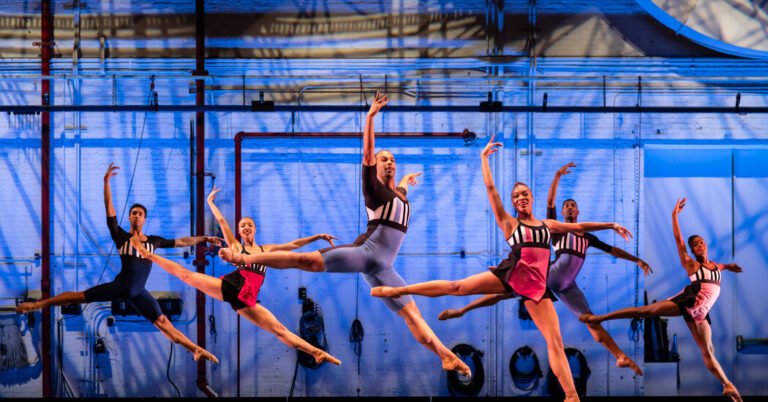It was, as Robert Garland said from the stage, a very important occasion for him. Congratulating the crowd on his first season in New York City Center as artistic director of the Dance Theater of Harlem, he spoke warmly of the company’s co-founder: “Arthur Mitchell was my mentor, my hero, and he was watching down from above saying, ‘Get well, Robert.’”
The line got laughs, but had the ring of truth – Mitchell was a strict director. And on Thursday, Garland showed she’s getting a few things right: Dance Theater, now in its 55th season, has a vintage kind of glow. It’s not like it was in the solid old days, but it has been refreshed. The company, along with its dancers, seems more sure of itself: It thrives on a sense of style.
Honoring Mitchell is a reminder of why Dance Theater, born after the assassination of Rev. Dr. Martin Luther King Jr. in 1968. Along with demonstrating the transformative power of ballet, Garland wrote in the program, Mitchell used Dance Theater as a means for social justice in part through its repertoire: George Balanchine ballets were performed with work by Black choreographers such as Geoffrey Holder. That taken into account, the curation remains caring.
Although there is no Garland premiere this season — she wants to get to know her dancers better before she creates a new ballet for them — Thursday’s program featured her charming, upbeat “Nyman String Quartet No. 2,” which weaves social dance with classical ballet. Nyman’s music still lives on, but since 2019, when the ballet premiered, the dancers have found greater comfort and stamina as they weave through the joyful combination of dances. And it made a further impression sharing the program with “Pas de Dix” (1955), Balanchine’s homage to Marius Petipa and his three-act “Raymonda” (1898).
A company premiere, “Pas de Dix,” set to Alexander Glazunov’s lively score, was staged by former New York City Ballet principal Kyra Nichols. Watching the dancers, a leading couple and an ensemble of eight, perform “Pas de Dix,” in its best moments, is like watching Nichols’ glimpses fly into space: technical and free with in -the-moment musicality. With a superb recording (none of the evening’s music was played live), this is a feat.
As a dancer, Nichols seems to breathe music; in “Pas de Dix,” his cast moves with gumption. Kamala Saara and Kouadio Davis, the leads, work well — especially Saara, whose command and control contrasts beautifully with her expressive arms and hands, framing her face as she shapes the air . But ballet is revealing, both stylistically and physically; The arrangement of the body — soft and open above and rock solid below — is a fierce balancing act.
These dancers have to practice it over and over again so they can see their individuality in it — essentially, wearing the ballet instead of letting it wear them. But this is a start. The original female lead was the formidable Native American ballerina Maria Tallchief, Mitchell’s favorite; her elegance and honesty, even in photographs, is overwhelming. “Pas de Dix” is a significant follow-up to last season’s company performances of Balanchine’s “Allegro Brillante” (1956), another bravura ballet that featured Tallchief.
Ballet can mean many things these days, but Balanchine’s great performance is still what it’s all about — especially for this company, known, especially in its early days, for dancing of his ballets and dancing them well.
At the New York premiere of “Take Me With You” by Robert Bondara, set to the Radiohead song “Reckoner,” Amanda Smith — in tight black shorts with a white button tied in a knot above her waist — entered the darkened stage clapping her hands. Elias Re, wearing the same outfit with his shirt untucked, stood behind him, snapping his fingers before turning Smith around in his arms, sharply at first and then more cautiously.
As the choreography flickers between sharp and dreamy, the dancers – sleek but somehow still vulnerable – are transported to the music. Bondara, a Polish choreographer, makes room for give and take. Even if the dancers roll around on the floor or hold each other’s hands, you understand that this is a partnership.
When Smith bent over Re’s chest and tapped his fingers against his body to the beat of the music, he didn’t move but leaned back. “Take Me With You” is both empty and emotionless: There may be darkness swirling around the world, but they have each other, as strange and lovable as modern-day. Nick and Nora.
While long, Thursday’s program has scope. It ended with “Blake Works IV (The Barre Project)” by William Forsythe, part of a series of dances set to electronic music by James Blake. Created for Dance Theater in 2023, it features a ballet barre backstage, which operates first as a base and then as a launching platform for dancers, in glowing purple, who perform barre exercises before take off on a wider stage. space. This Forsythe work, you might say, has been good for them all. They wear it. They hear its propulsive beat, and they make it their own.
Dance Theater of Harlem
Through Sunday in New York City Center, Manhattan; nycitycenter.org.
